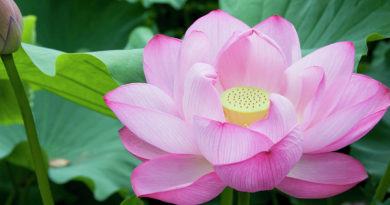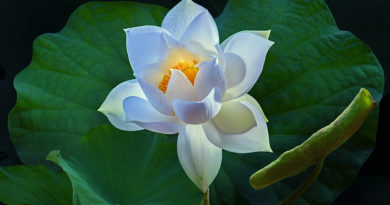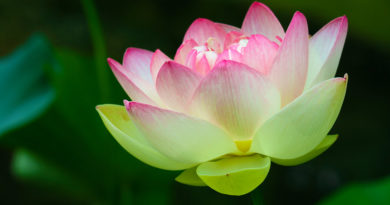HANDBOOK FOR MANKIND – 8. INSIGHT, BY ORGANIZED TRAINING
HANDBOOK FOR MANKIND – 8. INSIGHT, BY ORGANIZED TRAINING
Now we shall deal with the organized systems of insight training, which were not taught by the Buddha but were developed by later teachers. This kind of practice is suitable for people at a fairly undeveloped stage, who still cannot perceive the unsatisfactoriness of worldly existence with their own eyes, naturally. This doesn’t mean, however, that the results obtained by these systems have any special qualities not obtainable by the nature method, because when we examine the Tipitaka closely, we find the nature method is the only one mentioned. Some people consider, however, that natural insight can be developed only by someone who has become so remarkably virtuous, or has such a suitable disposition, that for him to come to a full understanding of things is just child’s play. What is a person to do who lacks transcendent virtues and the appropriate disposition? For such people, teachers laid down ordered systems of practice, concise courses which start from scratch and have to be followed through thoroughly and systematically.
These systems of practice for developing insight are now known by the technical term “Vipassana – dhura.” Vipassana – dhura is contrasted with Study (Gantha – dhura), the two being considered nowadays complementary aspects of training. Vipassana- dhura is study done within; it is strictly mental training, having nothing to do with textbooks. Neither the term Study (Gantha – dhura) nor Vipassana – dhura is mentioned in the Tipitaka, both appearing only in later books; but Vipassana – dhura is nevertheless a genuine Buddhist practice, designed for people intent on eliminating suffering. It is based directly on sustained, concentrated introspection. In order to explain Vipassana to people, teachers in former ages considered it in terms of the following questions: What is the basis, the foundation of Vipassana? What are the characteristics by which we may know that this is Vipassana? Just what is the activity called Vipassana? What should be the ultimate result of Vipassana?
Asked what is the basis, the foundation of Vipassana, we answer: morality and concentration. “Vipassana” means “clear insight,” and refers to the unobscured vision that may arise when a person’s mind is full of joy and devoid of any defilement. Joy develops when there is Moral Purity (Sila visuddhi); morality is a prerequisite. This is stated in the texts (Rathavinitasutta, Majjhima – nikaya, 24), where the practice is described as proceeding in a series of stages called the Seven Purifications, and culminating in the Path and the Fruit. Teachers regard the attainment of Moral Purity as the first of the Seven Purifications. It consists of faultless behavior and is prerequisite to purification of the mind (Citta – visuddhi). Purification of the mind, achieved when the mind has been rendered free of any contamination, is conducive to Purification of Views (Ditthi- visuddhi) or freedom from misunderstanding. Freedom from misunderstanding leads to purity by freedom from doubt (Kankhavitarana- visuddhi), and this conduces in its turn to the arising of purity by knowledge and vision of what is the true path to be followed and what is not the path (Magga – magga – Nanadassana – visuddhi). This knowledge of the path to be followed leads to the purity by knowledge and vision of the progress along the path Patipada – Nanadassana visuddhi). This finally leads to the last stage of full intuitive insight or purity of knowledge and vision (Nanadassana – visuddhi), which is the perfection of the very Noble Path. Because the Fruit of the Path arises automatically once the Path is established, the attainment of the Path is regarded as the culmination of the practice.
Moral purity is faultless behavior by way of body and speech. As long as any imperfection in body or speech remains, morality in the true sense is lacking. When it has been perfected, that is, when tranquillity of bodily activities and speech has been achieved, the result is bound to be mental tranquillity, conducive in its turn to the further stages of purification: freedom from misunderstanding, freedom from doubt, knowledge as to what is the Path to be followed and what is not, knowledge and vision of the progress along the Path and finally full intuitive insight. These last five stages constitute vipassana proper. Purification of conduct and mind are merely the entrance into the path of vipassana.
THE SEVEN PURIFICATIONS, THE FIVE STAGES IN VIPASSANA, AND THE NINE STEPS IN THE PERFECTION OF KNOWLEDGE:
I Moral purity II Mental purity III(1) Freedom from false views IV (2) Freedom from doubt V (3) Knowledge and vision of what is the true Path VI (4) Knowledge and vision of the progress along the Path (a) Knowledge of arising and passing away (b) Knowledge of passing away (c) Awareness of fearsomeness (d) Awareness of danger (e) Disenchantment (f) Desire for freedom (g) Struggle to escape (h) Imperturbability (i) Readiness to perceive the Four Noble Truths VII (5) Full Intuitive Insight
The Purification consisting of freedom from misunderstanding implies the elimination of all false views, both inborn and acquired. It covers the whole range from irrational belief in magic to false ideas as to the true nature of things-for instance, regarding this body and mind as something enduring, something worthwhile, a self; seeing it as animal, human being, celestial being, or god, or as something magical or sacred; failing to perceive that it consists of just the four elements, or of just body plus mind, and regarding it instead as a self, as possessing a soul or spirit, which enters and leaves it; failing to see it as consisting of the five aggregates: body, feeling, perception, active thinking and consciousness; failing to see it as just a mass of perceptions received by way of the eye, ear, nose, tongue, body and mind. False views lead to belief in magic and sacred objects, and so give rise to fear. Rites and rituals are then performed to neutralize the fear, and the end result is firm attachment to rites and rituals-all on account of false views. Such a situation indicates views that are not as yet faultless. To have given up false views is to have attained what was originally called the third Purification, and what later teachers classed the first stage in vipassana.
The Purification consisting of freedom from doubt is brought about by introspection into causes. With freedom from false views, one sees oneself as just body plus mind. Freedom from doubt consists in perceiving the nature of the causes responsible for the coming into existence of the body-mind complex. One sees penetratingly and in fine detail the coming into existence and the interaction of ignorance, desire, grasping and clinging karma, “nutriment,” and so on, to form body and mind. Freedom from doubt results simply from this clear knowledge of the causes and effects of all things. In the vipassana system, teachers recognize twenty or thirty kinds of doubt, but summed up they all amount to doubt as to whether or not “one’s self” exists, whether or not “one’s self” existed previously, whether or not “one’s self” will continue to exist in the future and, if so, in what form. The only way doubt can be completely dispelled is to realize that there is no “I,” but only elements, aggregates, a nervous system together with such causes as ignorance, craving and attachment, karma, “nutriment,” and so on. Because no real “I” is involved at all, one starts giving up the foolish idea: “I am, I have been, I shall be.” With the complete eradication of doubt, the second stage in vipassana has been achieved. This does not mean that the “I”- conceit has been given up for good and all; fine vestiges are still present. Adequate understanding of the mode of interaction of causes has resulted in the dispelling of doubt and has made it possible to give up the idea of “I” in its grossest forms.
When doubt has been transcended, it becomes possible to bring about the Purification consisting of perfect knowledge as to what is the right path to follow and what is not. There exist several obstacles to this further progress, which usually arise in the course of vipassana practice. While the mind is in a concentrated state, there are likely to arise various strange phenomena with which the meditator may become overawed, such as wonderful impressive auras seen in the mind’s eye (the physical eyes being shut). If these effects are purposely encouraged, they can become highly developed; and if the meditator jumps to the conclusion that “this is the Fruit of vipassana practice,” or congratulates himself saying, “This is something supernatural; this will do me!” and the like, the arising of these phenomena is liable to bar the way to the true Path and Fruit. Consequently, teachers consider it a side track, a blind alley. Another example is the arising of feelings of joy and contentment which continually overflow the mind to such an extent that it becomes incapable of any further introspection, or jumps to the conclusion that “this is Nirvana, right here and now,” so that the way becomes blocked and further progress is impossible. This is another obstruction to insight. Teachers say, furthermore, that even insight into the nature of body and mind may sometimes lead to self satisfaction and the delusion that the meditator has a remarkable degree of spiritual insight, so that he becomes overconfident. This too is an obstacle to progress in vipassana. Occasionally the meditator may make use of the mental power he has developed to make his body go rigid, with the result that he loses the awareness necessary for further introspection. This is a stubborn obstacle in the path to further progress, yet meditators usually approve of it, regarding it as a supernatural faculty, or even as the Fruit of the Path. Anyone who becomes so pleased with and infatuated by the attainment of deep concentration, this sitting with body rigid and devoid of all sensation, that he is unable to progress further in vipassana, is in a most pitiable position.
Another condition that may very easily come about is a blissful rapture the like of which the meditator has never encountered before. Once arisen it induces wonder and amazement and unjustified self satisfaction. While the rapture lasts, he body and the mind experience extreme bliss and all problems vanish. Things that formerly were liked or disliked are liked or disliked no longer when recalled to mind. Things the meditator had formerly feared and dreaded or worried and fretted over no longer induce those reactions, so that he gets the false idea that he has already attained liberation, freedom from all defilements; because for as long as he is in that condition he has all the characteristics of a genuinely perfected individual. Should satisfaction arise with respect to this condition, it acts as an obstacle to further progress in vipassana. And in time the condition will fade away so that things formerly liked or disliked will be liked or disliked again just as before, or even more so.
Yet another kind of obstacle involves faith. Faith or confidence never felt before becomes firmly established, for example confidence in the Threefold Gem, Buddha, Dhamma and Sangha, or in theories the meditator thinks out for himself. There may even come about a most intense satisfaction in Dhamma. The ability to remain unmoved by anything becomes so strongly developed that it may even delude the meditator into believing he has already attained the Fruit of the Path and Nirvana itself. These things are a great difficulty for anyone encountering them for the first time. As you can see they constitute a barrier in the way of vipassana. The meditator, however, is likely to regard them as highly desirable until such time as he develops the unobscured knowledge that these things are in fact obstacles and succeeds in cutting out these finer defilements completely. This knowledge of what is the right path and what is not constitutes the third stage in vipassana and the fifth Purification.
Until such time as the aspirant has developed this knowledge of what really constitutes the right path, he has to be always steering himself away from the various side tracks. Once this knowledge of the path to be followed has become fully established, however, any further knowledge will automatically develop along the right line. It will progress step by step, bringing perfectly clear understanding of the true nature of things and ultimately perfect freedom from, and non-involvement in things. The mind, equipped with this right understanding, is all set to attain insight into the Four Noble Truths, and is said to have attained the Purity by Knowledge and Vision of the progress along the Path. This is counted as the fourth stage in vipassana and the sixth Purification. The Tipitaka contains no detailed explanation of the stages in this Knowledge and Vision of the progress along the Path, but later teachers recognized in it nine steps, as follows:
- a) Vipassana has progressed properly, and the birth, aging, pain and death of phenomena have been thoroughly scrutinized. The arising and passing away of phenomena has been perceived in all clarity. All phenomenal existence is seen to consist of just an endless process of arising and ceasing like the glittering dazzle on the surface of the sea, or like the forming and bursting of the foamy crests of waves. This is known as knowledge of arising and passing away (Udayabbayanupassana – nana). It is brought about by concentrated introspection so clear, and sustained for so long a time that the knowledge becomes firmly established, like a dye absorbed by the mind, powerful enough to make the meditator become disenchanted with things and give up clinging to them. This is the first step in the Knowledge and Vision of the Progress along the Path.
- b) Arising and passing away, if observed simultaneously, cannot be perceived with such clarity as they can if either one is concentrated on separately. At this stage, the meditator gives up watching one of the two, namely arising, and concentrates exclusively on the passing away. This permits him to see the process of disintegration and decay in such depth and intensity that he comes to realize that decay and perishing are universally evident no matter where in the world one looks. A mind dwelling in this knowledge is said to be equipped with knowledge of decay and dissolution (Bhanganupassana – nana). This is the second step in the developing of knowledge.
- c) Knowledge of decay and dissolution, when sufficiently well developed, gives rise next to the awareness that all things are to be feared. All phenomenal existence, whether in the sensual realm, in the form realm, or in the formless realm, is seen as inherently fearsome. All spheres of existence are seen as thoroughly fearsome because the decay and dissolution of all phenomena is perceived in every conscious moment. Thus an intense apprehension arises in the mind of one possessing this awareness and becomes established as a genuine fear. This awareness sees nothing but fearsomeness, like poison, or deadly weapons, or vicious armed bandits, completely filling the three spheres of phenomenal existence-nothing but fearsomeness. This awareness of the fearsomeness (Bhayatupatthana-nana) of all phenomenal existence is reckoned as the third step.
- d) When awareness of the completely fearsome nature of all phenomenal existence has been fully developed, there will arise in its turn awareness that all things are inherently dangerous. To become involved in things is not safe. They are like a forest full of dangerous beasts, and anyone seeking diversion in the forest finds nothing pleasing there. This awareness of the danger (Adinavan- upassana – nana) inherent in all phenomenal existence is the fourth step.
- e) When all things are seen to be in every way full of danger this gives rise to disenchantment. Things are seen as resembling a burntout house of which nothing remains but ashes and a skeleton, utterly unattractive. This disenchantment (Nibbidanupassanaa – nana) with having to be associated with conditioned things is the fifth step in the developing of knowledge.
- f) When genuine disenchantment has become established, there arises a desire to become really free from those things. This is quite unlike our ordinary desire for freedom, which, lacking the power of concentration or insight to boost it up, is not real desire for freedom. The disenchantment arising out of vipassana insight involves the entire mind; and the desire for freedom is as great as the disenchantment, so is very real and genuine. This desire to escape from the unsatisfactoriness of phenomenal existence is as great as the desire for freedom a frog struggling to escape from a snake’s jaws, or the desire for freedom of a deer or bird struggling to break loose from a snare. This real desire to escape (Muncitukamyata – nana) from unsatisfactoriness is the sixth step.
- g) Now with the full development of the desire to escape, there arises a feeling of an intense struggling to find a way out, an ever- present feeling that, phenomenal existence being as it is, one has to escape from it. Introspecting, one perceives the clinging and one perceives the defilements that are the cause of the mind’s bondage, the fetters binding it securely to that condition. Consequently one seeks for ways of weakening the defilements. Then seeing the defilements weakened, one sets about destroying them completely.
This weakening of the defilements is illustrated by means of a simile. A man goes to his fish trap and pulls out a snake thinking it to be a fish. When told it is a snake, he doesn’t believe it, at least not until he meets a wise, benevolent and sympathetic teacher, who guides and instructs him so that he comes to realize that it is in fact a snake. He then becomes afraid and searches about for a means of killing it. He grabs the snake by the neck and, lifting it above his head, swings it in a circle until it is worn out and falls down dead. This simile illustrates the arising of the knowledge that the defilements are the cause of people’s bondage to a condition much to be feared and dreaded.
If one has no technique for reducing the force of the defilements day by day, eradicating them is bound to be impossible. The power of the defilements far exceeds that of the still meager knowledge to be used in destroying them; hence knowledge must be developed and increased, and the suffering produced by the defilements will simultaneously diminish. Always maintaining and developing the knowledge that all things are transient, worthless and devoid of selfhood, that they are not worth getting or being, serves to cut off the food supply to the defilements, weakening them day by day. It behooves us to build ourselves up, develop, become more skillful and ingenious. By this means, we can conquer defilements the size of mountains, small though we may be. Our situation can be compared to that of a small mouse faced with the job of killing several tigers. We have to be really steadfast and always on the lookout for means appropriate to a small mouse. If we get nowhere, we must use all sorts of devices and techniques to weaken those tigers day by day rather than trying to kill them outright. This intense search for a way of escape (Patisankhanupassana – nana) constitutes the seventh step in the Knowledge and Vision of the Progress along the Path. h) This weakening of the defilements serves to make us progressively more and more independent of and oblivious to things. So this next step in the developing of right understanding, which results in imperturbability with respect to all things, consists in seeing all phenomena as empty, as devoid of essence, as devoid of status such as “animal” or “person,” devoid of substance or real permanence, devoid of worth because they are thoroughly unsatisfactory, and devoid of all attraction because they are thoroughly disenchanting. Ultimately the mind becomes independent of and unperturbed by anything in any realm of existence. Things formerly likable, desirable and infatuating, come to be seen as lumps of rock and earth.
This too has been explained by means of a simile. A man who has always loved a certain woman may one day experience a change of heart and stop loving her. For instance, he will stop loving his wife if she is unfaithful. Once divorced, however, he is free to go ahead and do as he pleases; his mind can be unperturbed. And at this level of knowledge, conditions hitherto delightful, each in its own way, are recognized as devoid of substance, so that one can be independent of them and unperturbed by them in all circumstances, just like the man who becomes independent on divorcing his wife. This indifference to all phenomena (Sankharupekkha – nana) is the eighth step.
- i) The mind thus independent of and unmoved by all phenomenal existence is ready to perfect the Path and know the Four Noble Truths (Saccanulomika – nana). At this stage one is all set to overcome the defilements, to break the fetters binding one to the world, and become an Aryian of one degree or another. This is the ninth step in the process of Knowledge and Vision of the Progress along the Path.
When this stepwise developing of knowledge, from knowledge of arising and passing away up to the state of readiness to perceive the Four Noble Truths, has been carried through to completion, one is said to have achieved the fourth state in vipassana, or the sixth Purification. The pure and perfect knowledge it yields is an instrument that reveals to the meditator the path by which he has come, and can lead on to the perfect intuitive insight that will destroy the defilements.
This perfect intuitive insight, or Purity of Knowledge and Vision, the seventh Purification, is the insight that arises out of the perfected Path. It is the goal, the Fruit of vipassana practice. This insight that arises out of the perfected Path is the fifth and final stage in vipassana. In between the state of readiness to perceive the Noble Truths and this perfect intuitive insight comes “qualifying” knowledge (Gotrabhu – nana), which marks the point of transition from the ordinary defiled individual to the Aryian. But this qualifying knowledge lasts only an instant. It is the culmination of the progressive perfection of knowledge and is still at the level of good karma, still in the sensual realm.
To sum up, then, vipassana has as its foundation morality and concentration. What do we examine? The answer is: We examine all things, or to use other terms, the world, or phenomenal existence, or conditioned things, or the five aggregates, since all phenomenal existence consists of nothing apart from the five aggregates. What do we aim at seeing as a result of this scrutiny? We aim at seeing the transience, the unsatisfactoriness, the non-selfhood inherent in all things in the world. We observe them arising, persisting and ceasing until we come to perceive them as absolutely fearsome and disenchanting, and realize that nothing is worth getting or being. These are the conditions that ought to arise in vipassana practice. What is the objective of vipassana? The immediate objective of vipassana is to reduce delusion, the meaning of “vipassana” being “clear vision.” What is the fruit of vipassana? The fruit is the arising of clear intuitive insight, clear and enduring insight into the nature of all things, which ultimately will reduce the defilements to nothing. With the defilements gone, there is just perfection, enlightenment, peace. Nothing remains to bind the mind to any worldly condition. As a result, there comes about a slipping free from the world, this place of slavery to sensuality. The mind is freed of suffering because it’s freed for good of all craving or desire. The Buddha called this the attainment of the cessation of suffering, the attainment of the Fruit of the Path, Nirvana. To have achieved this is to have carried out to completion the task Buddhism has set for us.
This shows us the path of insight that has to be walked. There are seven stages of Purification which must be integrated in this way, and nine steps in the process of developing knowledge of the world. These taken together are known as vipassana. In the Texts it is set out as an ordered system. The finer details can be found in the books written by later teachers. There is one important thing that must be realized, however, in order to avoid misunderstanding. It so happens that even in the field of Dhamma practice, the highest aspect of Buddhism, there are misguided people. At the present time there are many who have got hold of things that are not vipassana at all and are presenting them as being the real thing. They have made vipassana practice their means of livelihood. They win people over in order to get classes together, then proceed to certify them as noble ones (Ariyapuggala), modern style, all of which is most despicable and regrettable.









